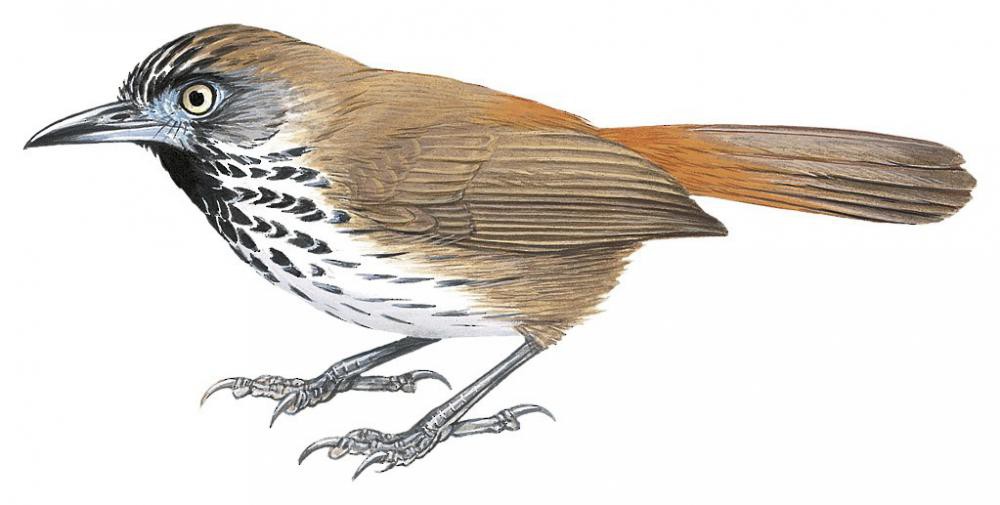Chestnut-rumped Babbler / Stachyris maculata

Chestnut-rumped Babbler
SCI Name:
Protonym: Timalia maculata Pl.Col. livr.100 pl.593 fig.1
Taxonomy: Passeriformes / Timaliidae / Stachyris
Taxonomy Code: chrbab1
Type Locality: Borneo and Sumatra ; restricted to Borneo, by Robinson and Kloss, 1918, Ibis, p. 588.
Author: Temminck
Publish Year: 1836
IUCN Status: Near Threatened
DEFINITIONS
STACHYRIS
(Timaliidae; Ϯ Grey-throated Babbler S. nigriceps) Gr. στραχυ strakhu rough, distort < τραχυς trakhus rough, jagged; ῥις rhis, ῥινος rhinos nostrils; "Timaliæ ... Stachyris, Hodgson. ... 1. St. nigriceps, Hodgson. ... 2. St. pyrrhops, Hodgson. ... 3. St. chrysæa, Hodgson. ... Mr. Hodgson sends the following diagnostics ... "Stachyris, Mihi. (Certhianæ? Leiotrichanæ? Parianæ? [I do not hesitate to place it as above.—E. B.] Bill equal to head, very strong, pointed, and trenchant; tips equal and entire; its form conico-compressed and higher than broad, with culmen raised between prolonged nareal fossæ. Nares basal, lateral, with ovoid posteal aperture, the front being closed by the very salient rude scale above. Gape smooth. Frontlet rigid. Tongue cartilaginous, bifid, simple. Legs and feet very strong, suited to creeping and climbing in inverted strained positions. Tarse very stout, longer than any toe or nail. Toes short, unequal, depressed, basally connected, the hind stoutest and exceeding the inner fore. Nails very falcate and acute. Wings short, feeble, the first four primaries much graduated, the four next subequal. Tail medial, simple, firm. Type St. nigriceps. Sylvan, shy; creeps among foliage, buds and flowers, like Zosterops and Orthotomus; feeds on minute hard insects and their eggs and larvæ." (Hodgson 1844).
Var. Stachyrhis, Strachyrhis, Strachyris.
Synon. Cilathora, Heterorhynchus, Nigravis, Sphenocichla, Stachyrirhynchus, Thringorhina.
maculata
L. maculatus spotted, blotched < maculare to make spotted < macula spot (cf. Late Med. L. maculatus reticulated, chain-mailed).
● ex “Pivote ortolane de Provence” of d’Aubenton 1765-1781, pl. 654, fig. 2, “Pivote ortolane” of de Buffon 1770-1786, and “”Spotted Wheat-ear” of Latham 1783 (?syn. Anthus trivialis).
● ex “Barbu à ventre tacheté de Cayenne” of d’Aubenton 1765-1781, pl. 746, fig. 1 (syn. Bucco tamatia).
● ex “Crabier tacheté de la Martinique” of d’Aubenton 1765-1781, pl. 912, and “Crabier vert tacheté” of de Buffon 1770-1786 (syn. Butorides striata virescens).
● ex “Soui-manga varié” of Audebert & Vieillot 1802 (syn. Chalcomitra fuliginosa).
● ex “Spotted-winged Fly-catcher” of Latham 1783 (syn. Chasiempis sandwichensis).
● ex “Cock Purple-breasted Manakin” of Edwards 1764, and “Cotinga du Brésil” of d’Aubenton 1765-1781, pl. 188 (Cotinga).
● ex “Gobe-mouche noir de Lorraine” of d’Aubenton 1765-1781, pl. 565, figs. 2, 3 (syn. Ficedula hypoleuca).
● ex “Matkneltzel” and “Matkern” of Willughby 1676 and Ray 1713, “Porphyrio punctulatus” of Brisson 1760, and “Speckled Gallinule” of Latham 1785 (syn. Gallinula chloropus).
● ex “Hatí manchado” (= ☼) of de Azara 1802-1805, no. 415 (syn. Sternula superciliaris).
● ex “Paloma parda manchada” of de Azara 1802-1805, no. 322 (syn. Zenaida auriculata chrysauchenia).
SUBSPECIES
Chestnut-rumped Babbler (pectoralis)
SCI Name: Stachyris maculata pectoralis
pectorale / pectoralis
L. pectoralis of the breast, pectoral < pectus, pectoris breast.
● ex “Engoulevent à collier” of Levaillant 1806 (Caprimulgus).
● ex “Janfréderic” of Levaillant 1801-1804, pl. 111 (syn. Cossypha caffra).
● ex “Austral Quail” of Latham 1823 (Coturnix).
● ex “Gold-breasted Manakin” of Latham 1801 (Euphonia).
● ex “Petit Merle brun à gorge rousse de Cayenne” of d’Aubenton 1765-1781, pl. 644, fig. 2, and “Yellow-breasted Thrush” of Latham 1785 (syn. Gymnopithys rufigula).
● ex “Red-breasted Snipe” of Montagu 1813 (syn. Limnodromus griseus).
● ex “Black-breasted Flycatcher” of Latham 1787 (Pachycephala).
● ex “Mbatuitui pecho listado” of de Azara 1802-1805, no. 389 (syn. Pluvialis dominica).
● ex “Tachurí pecho amarillo” of de Azara 1802-1805, no. 165 (Polystictus).
● ex “Black-breasted Grosbeak” of Latham 1783 (syn. Sporophila americana).
● ex “Cordon Noir” of Levaillant 1805, pl. 150 (artefact).
● ex “Hausse-Col Noir” of Levaillant 1802, pl. 110 (artefact).
Chestnut-rumped Babbler (maculata)
SCI Name: Stachyris maculata maculata
maculata
L. maculatus spotted, blotched < maculare to make spotted < macula spot (cf. Late Med. L. maculatus reticulated, chain-mailed).
● ex “Pivote ortolane de Provence” of d’Aubenton 1765-1781, pl. 654, fig. 2, “Pivote ortolane” of de Buffon 1770-1786, and “”Spotted Wheat-ear” of Latham 1783 (?syn. Anthus trivialis).
● ex “Barbu à ventre tacheté de Cayenne” of d’Aubenton 1765-1781, pl. 746, fig. 1 (syn. Bucco tamatia).
● ex “Crabier tacheté de la Martinique” of d’Aubenton 1765-1781, pl. 912, and “Crabier vert tacheté” of de Buffon 1770-1786 (syn. Butorides striata virescens).
● ex “Soui-manga varié” of Audebert & Vieillot 1802 (syn. Chalcomitra fuliginosa).
● ex “Spotted-winged Fly-catcher” of Latham 1783 (syn. Chasiempis sandwichensis).
● ex “Cock Purple-breasted Manakin” of Edwards 1764, and “Cotinga du Brésil” of d’Aubenton 1765-1781, pl. 188 (Cotinga).
● ex “Gobe-mouche noir de Lorraine” of d’Aubenton 1765-1781, pl. 565, figs. 2, 3 (syn. Ficedula hypoleuca).
● ex “Matkneltzel” and “Matkern” of Willughby 1676 and Ray 1713, “Porphyrio punctulatus” of Brisson 1760, and “Speckled Gallinule” of Latham 1785 (syn. Gallinula chloropus).
● ex “Hatí manchado” (= ☼) of de Azara 1802-1805, no. 415 (syn. Sternula superciliaris).
● ex “Paloma parda manchada” of de Azara 1802-1805, no. 322 (syn. Zenaida auriculata chrysauchenia).
Chestnut-rumped Babbler (banjakensis)
SCI Name: Stachyris maculata banjakensis
banjakensis
Banyak or Banjak Is., off the north-west coast of Sumatra, Indonesia.
Chestnut-rumped Babbler (hypopyrrha)
SCI Name: Stachyris maculata hypopyrrha
hypopyrrha
Gr. ὑπο hupo beneath; πυρρος purrhos flame-coloured, red < πυρ pur, πυρος puros flame.
UPPERCASE: current genus
Uppercase first letter: generic synonym
● and ● See: generic homonyms
lowercase: species and subspecies
●: early names, variants, mispellings
‡: extinct
†: type species
Gr.: ancient Greek
L.: Latin
<: derived from
syn: synonym of
/: separates historical and modern geographic names
ex: based on
TL: type locality
OD: original diagnosis (genus) or original description (species)












